Steering web guides are part of the intermediate web guide group.
These differ from the displacement guides in that they don't have a guide span made of two rollers. Steering web guides will typically have one guide roller installed on two raceways at an angle so the roller moves in an arc. The roller upstream from the steering roller is fixed. This arc movement provides the steering of the web.
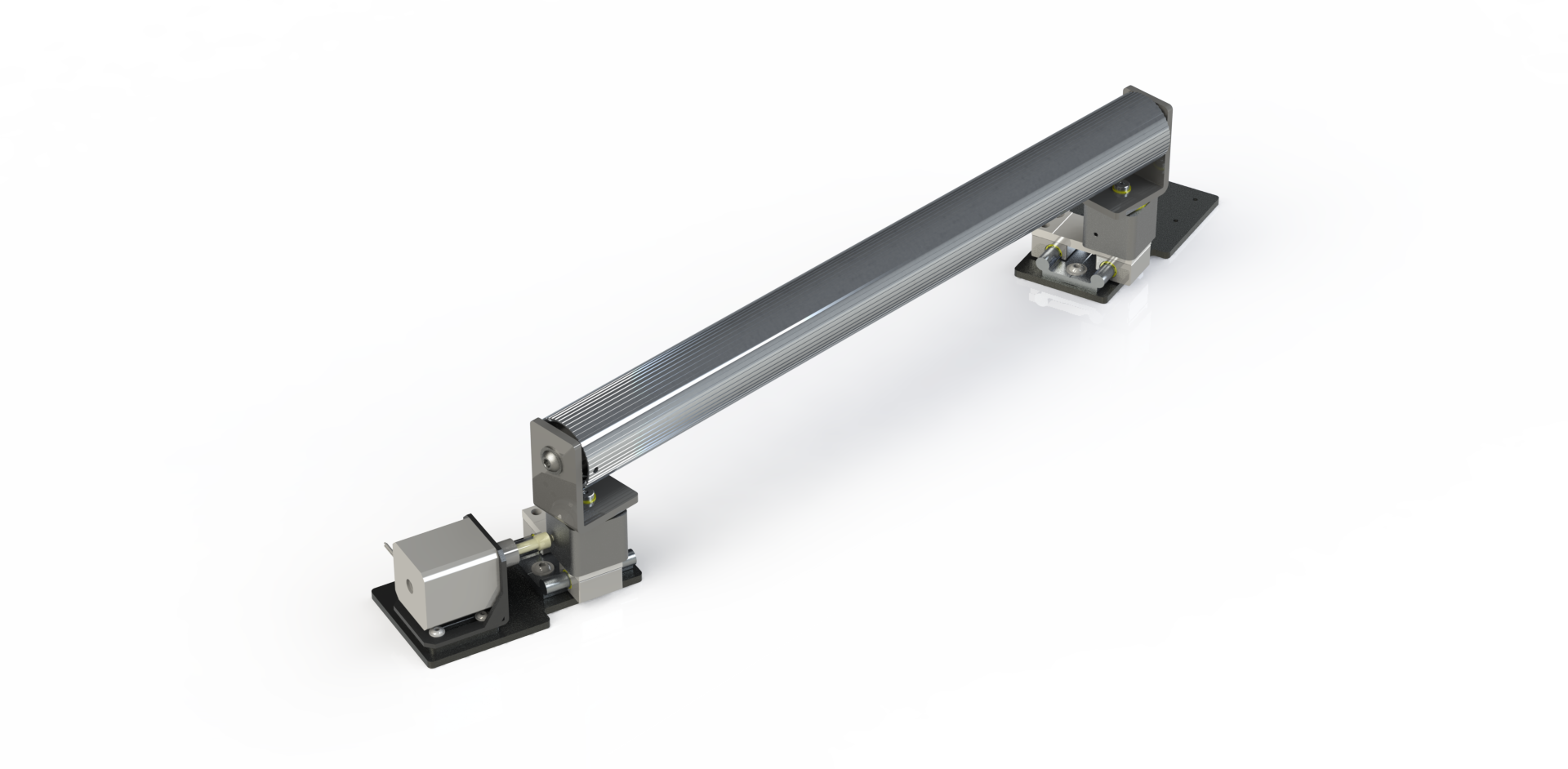
An instant center
For steering guides, a physical pivot point is absent. In this case the web guide system will have a virtual pivot point. A virtual pivot point is the location around which the web guide mechanism rotates. This is also called the instant center. A steering guide requires an instant center based on the arc of the steering roller. This instant center will fall somewhere between the guide roller and the fixed roller that create the entering span.
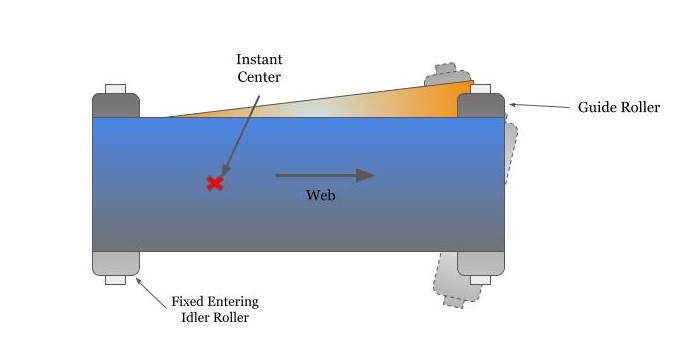
Because of this arc motion on the steering roller and the fixed roller before the steering roller, the web is subject to bending at the steering roller. This particular type of web guide displaces as well as bends the web as it corrects it's position.
As with the displacement web guide, there is an entry and exit span set to the guide roller. These entry and exit spans have conditions as to the required distance of the span. However, steering guides have to spans at the entry side of the web web and one at the exit.
Not the first option in web guiding
Steering web guides are not the first choice of guiding solutions, and is not recommended unless it is the only option available. Consider that the bending of the web introduces stresses on the web, especially at the edge of the web. If it is not installed properly, there will be issues with wrinkles, creasing, web tear, and issue with edge quality.
Minimum length of entry and exit span is determined by stiffness of the web, average stress, Young's Modulus and tension of the web, web width, and span length. There is a formula to determine the minimum entry and exit span length and you can contact us to discuss this formula. The entry and exit span do not have to be of the same length.
Installation considerations
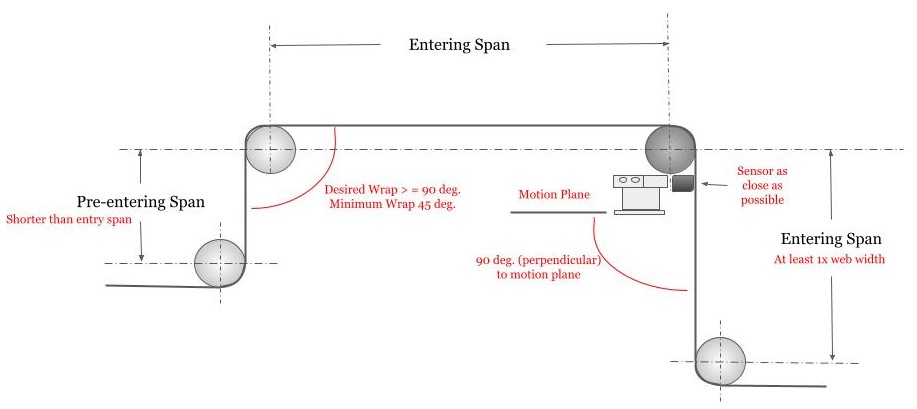
In steering guides, most of the installation considerations deal with the entry and exit span.
- The exit span must be perpendicular to the plan of motion of the web guide, in this case, the steering roller.
- As a general rule, entry span should be 1X to 5X the width of the web. Exit spans should be at leas 0.5X the web width.
- Web stiffness affects the length of the entry and exit spans; stiffer webs will require longer spans (10X for metals) and shorter for flexible webs (1X for nonwoven). There is a formula for determining the minimum span lengths, which we can guide you through.
- Instant center should be at 1/2 to 2/3 of the entering span length, This is set by the angle of the steering roller sliders.
- The pre-entry span should be shorter than the entering span.
These conditions come from the dynamic model of steering guides. If these conditions are not included in the installation of the steering guide, you will experience over-steering or under-steering. This will subject the web to unnecessary stresses, and will show up as wrinkles, slack edges or tight edges.
Additionally, we want to make sure that the angle between the motion plan and the exiting span is 90o, resulting in an exiting span that is perpendicular to the motion plane of the steering roller.
The entering span is usually fairly long and the wrap angle angle around the steering roller made by the exiting span and the entering span should be 90o, but it can by + or - 45o. The same can be said for the wrap angle around the idler roller between the pre-entering span and the entering span, recommended 90o, but + or - 45o is acceptable. Now, bear in mind that by reducing or increasing the wrap angle around the steering roller you are introducing bending stresses on the web through the entering span and the pre-entering span. The result would be moment transfer upstream through the idler roller. This means that the motion of the steering roller could move the web a the idler roller and further upstream. To avoid that we would keep the wrap angle around the idler roller as close as possible to 90o, and the pre-entering span shorter than all other spans in the web guide set up.
As with any web guiding system, we want to have our sensor as close as possible to the steering roller on the exiting span.
Steering guide installation mistakes
The three most common steering installation mistakes deal with the location of the sensor, perpendicularity of the motion plane and the exiting span, and the length of the pre-entering span in relation to the entry span.
We do not want to place the sensor too far away from the steering roller on the exiting span, or place the sensor on the span after the exiting span. This will lead to understeering and
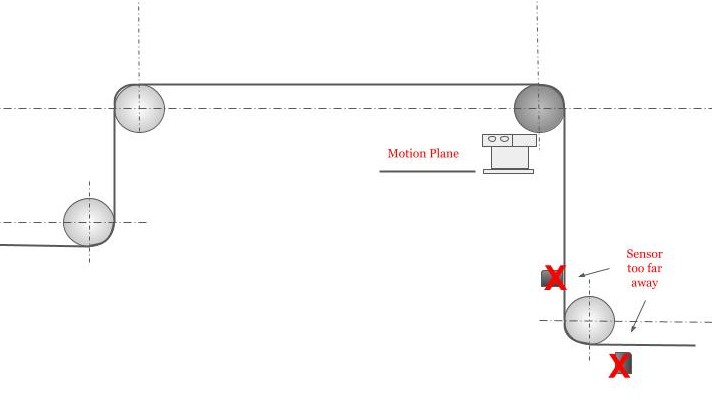
Additionally, we need to verify that the exiting span is perpendicular to the motion plane of the steering roller. The most common problem faced with this condition is that the web will be subject to bending, and therefore, unnecessary stresses that will result in wrinkles, web tears, and
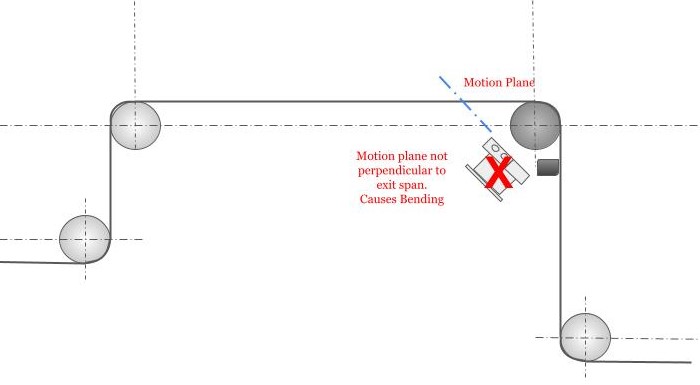
Steering web path options
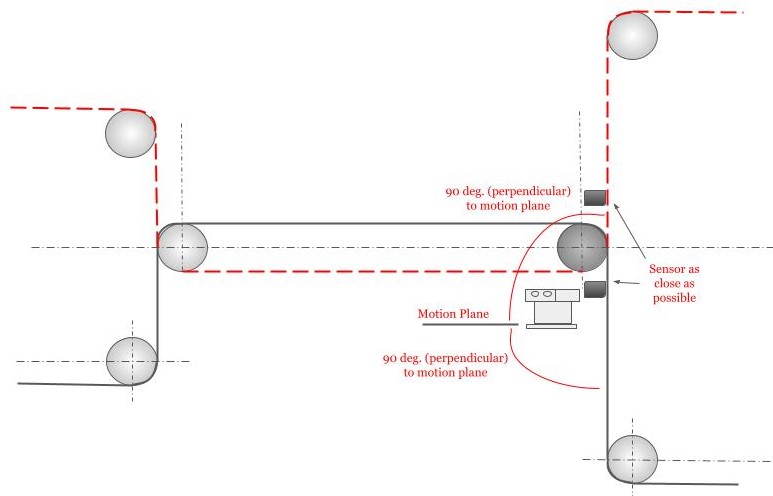
Similar to displacement web guides, steering guides offer an array of web paths to accommodate for specific conditions in a converting line. However, all the installation conditions must be followed for the proper function of the web guide system.
Summary
Design Considerations
As with displacement web guides, the desired correction is the main parameter that needs to be addressed for the proper design of the steering guide. Consider that the movement of the steering roller is limited by the stroke of the actuator and the plane change of the web on the exiting span. The arc of the steering roller is limited to +/- 5o to insure that the web is not too far away from the sensor at an extreme position of the steering roller. Additionally, the raceways upon which the steering roller moves should not exceed an angle of 25o, with 5o to 20o as the preferred range of the raceway angle.
Installation Considerations
Steering guides are more complicated to install. Web stiffness will determine the entry span length. The proper entry span length will reduce the chances of wrinkling and unnecessary stresses on the web. The race way angle will determine the instant center location, however, we must make sure that the instant center is located on the entering span within the range of distances mentioned before. Last we must always design our steering guide so the exit span is perpendicular to the plane of motion.
Advantages
The main advantage to using steering guides is the reduced cost in manufacturing the mechanism in comparison to other types of guides
Disadvantages
At the same time that they are simple and inexpensive to manufacture, steering guides are hard to install due to amount of attention to detail required. Remember the many parameters that have to be considered, such as span lengths, angle of steering roller raceway, 90o angle between exit span and motion plane, etc.
Any deviation from the recommendations presented here will result in poor installation of the web guide, and will create wrinkles, edge stresses and instability in the web.
As mentioned before, wrap angle deviations will also result in traction loss and cause moment transfer and amplification error.
Approaching a web guiding solution for your converting operation
Web guiding design is not something that you should embark alone. We are available not only to help you in designing a proper web guide solution for your operation, but also in providing support in analyzing your particular application. It all starts with contacting us to begin the process of solving your web guiding issue.
Our next blog will present other less common web guiding applications that are available to you.
We invite you to follow us on facebook, linkedin and twitter to stay up to date on our developments and other instructional materials. Sign up on our website and get monthly emails on products, applications and developments.
